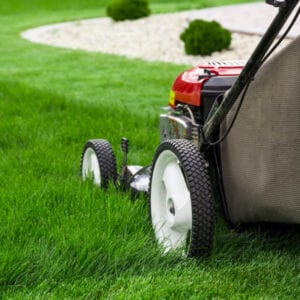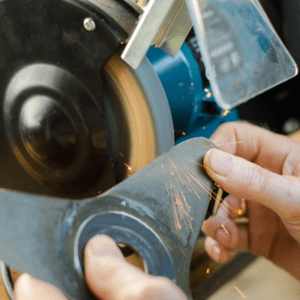When it comes to lawn care, even gardeners with good intentions can negatively impact their lawn’s health if they’re not careful. As the warm weather rolls out, be sure to avoid making these five common lawn care mistakes.

Common Lawn Maintenance Mistakes
1. Mowing Incorrectly
Mowing may seem like a no-brainer, but if you don’t do it correctly, you can set your lawn up for catastrophe. The first thing you need to be sure of is which height to set your mower to. Here in Delaware, we have cool-season grasses in our lawns. You can use this reference sheet below to figure out which height is best for your lawn. If you’re not sure which is the dominant grass varietal in your lawn, you can always ask the team at Quality Cut!
Turf species Set mower to Mow when turf reaches
Annual ryegrass 1 1/2 – 2 inches 2 1/4 – 3 inches
Colonial bentgrass 1/2 – 1 inch 3/4 – 1 1/2 inches
Creeping bentgrass 1/2 inch or less 3/4 inch or less
Hard fescue 2 1/2 inches 3 3/4 inches
Kentucky bluegrass 1 1/2 – 2 1/2 inches 2 1/4 – 3 3/4 inches
Perennial ryegrass 1 1/2 – 2 1/2 inches 2 1/4 – 3 3/4 inches
Red fescue 1 1/2 – 2 1/2 inches 2 1/4 – 3 3/4 inches
Rough bluegrass 1 – 2 1/2 inches 1 1/2 – 3 3/4 inches
Tall fescue 1 1/2 – 3 inches 2 1/4 – 4 1/2 inches
Source: University of California, Statewide Integrated Pest Management Program
2. Bagging The Clippings
Now, there’s no law against bagging the clippings, and we understand that it doesn’t look as pristine when you mulch the clippings. However, if you mow your grass regularly, and the clippings aren’t too long, you’re really doing your grass a disservice by not mulching the clippings and returning them to your lawn as you mow. They will break down naturally and keep vital nutrients in your soil. This means you may need to fertilize as often.
It’s important to note that a caveat of this mistake has a mistake of its own. If you choose to mulch your clippings, make sure to follow these rules:
- Never mow damp grass. The cut won’t be as good and can clog the mower.
- If the grass is too long, the clippings will have the opposite effect and smother the grass.
3. Keep Mower Blades Sharpened
Mowing with a dull blade creates ripped grass blades. Ripped grass blades are more prone to developing fungal diseases and will have browned look to them. Not something that you want for your lawn.

4. Overdoing The Mulch
Mulch is not only grass clippings but plenty of other organic materials as well. Straw, dead leaves, and wood chips are some of the most common. Adding a layer of mulch to your flower beds or around trees and shrubs can help suppress weed growth and retain moisture. However, many people fall into the trap of “more is better” when it comes to mulch. This isn’t necessarily the case. In fact, some people make the mistake of creating a “mulch volcano” around their trees. This can actually cause the tree to put roots above the earth in the mulch and not below it. As you can imagine, this weakened root system is not as stable, and it doesn’t look very pleasant. Too much moisture retention from overuse of mulch can also invite mold, mildew, fungi, and other lawn diseases that thrive in dark, damp environments. If you’re not sure which mulch to use or don’t want to do the manual labor, Quality Cut can do it for you as part of our lawn care services.
5. Using The Wrong Fertilizer
In case you didn’t know, fertilizer comes in ratios of the three key macronutrients that all lawns crave: nitrogen, phosphorous, and potassium. You may have noticed bags of fertilizer that have ratios like 5-7-4. This means that particular fertilizer has proportions of 5 parts nitrogen, 7 parts phosphorous, and 4 parts potassium. Many homeowners make the same mistake with mulch as they do fertilizer: more must be better. Unfortunately, too much nitrogen can actually burn the grass!
To avoid making this mistake, the first thing you should consider is an at-home soil test. This will tell you which nutrients your lawn is lacking and which ones are abundant. From there, you can take a targeted approach to fertilize your lawn.
6. Overwatering
As we’ve already discussed, excess moisture opens the floodgates – pun intended – to various diseases. It can also cause soil erosion. If your lawn has thinning or bare patches, the soil can wash away during heavy rains since there’s nothing to hold it in place. Most grass varieties only need about 1.5 inches of water a week at maximum – and that includes any rainfall.
Find Lawn Care Near Wilmington, DE
If the idea of researching and implementing all of the above best practices feels overwhelming or time-consuming, we can help! The experts at Quality Cut Lawn Service can help! We offer a variety of lawn care programs like mowing, fertilization, and mulching. We’d love to talk to you about your lawn care goals and any concerns you may have. Call 302-420-7597 or leave us a message online here.
To learn more about lawn care, landscaping, and other topics, check out our monthly blog.
